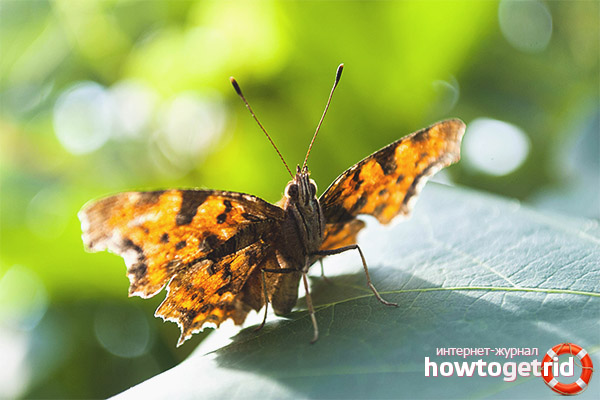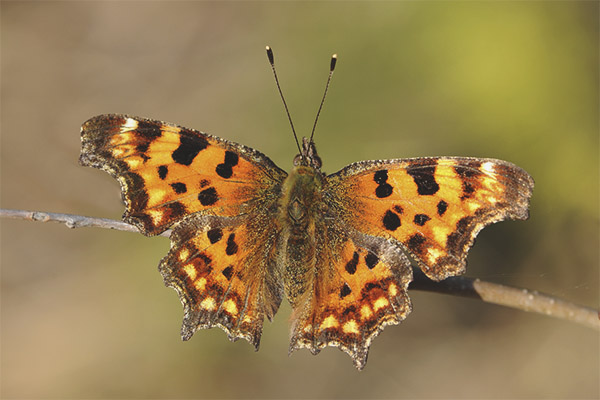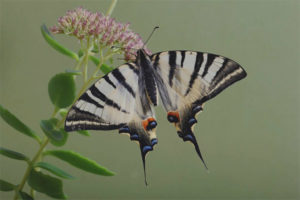The content of the article
Butterflies are one of the most beautiful arthropod species. The bright color of their wings attracts the attention of not only entomologists, but also ordinary inhabitants. Almost all butterflies have a proboscis structure of the oral apparatus and are completely safe for humans. In addition to the interesting color, there are butterflies with an unusual shape of the wings. These include butterfly-anglers.
Genus description
Butterflies belong to the class of insects, the order of Lepidoptera. Rod genus includes 16 species. All of them have the same wing structure, but its different color. The most common type is the C-White Dome. She received such a name for the fact that on its back wings there is a semicircle of white color resembling the letter C.
A distinctive feature of all butterflies of this genus are characteristic clippings on the wings.The upper wings have one semicircular notch so that two corners are formed on each wing. The lower wings have two clippings so that an angle forms between them.
The color of butterflies is not bright. Almost all members of this genus have brown-brown color, merging with the color of the bark of trees. This is due to the nature of the food and habitat of butterflies.
Habitat
Butterflies are found quite often in all countries of Europe, in Russia, Japan, China, as well as in some countries of Central Asia and North Africa, in parts of North America. It is difficult to say exactly where the butterflies more. In different parts of their habitat, hypochs may appear in larger or smaller quantities.
Types of sticks
- C-white. This species was discovered before the rest in the middle of the 18th century. As it turned out later, this is the most common type of stools.They are found throughout the entire habitat. Their characteristic feature is the semi-circular white C on the hind wings.
- C-gold. In appearance, it is very similar to the one described above, but the semicircle on the rear wings has a golden color. It was discovered a few years after C-white.
- Southern or Aegean Angle Wing. The name of this species comes from the fact that its representatives are more common in the southern part of the habitat of the species. However, as it turned out later, they can be found in Eastern Europe, but in smaller quantities. The bright spot on the back wing of this butterfly has the shape of the letter U.
- Combo gadget. This butterfly was discovered 100 years later than its predecessors. This is due to habitat - it is found exclusively in North America and then only in a few states. It differs from other representatives of the species by a brown stripe on the hind wings, which is comma-shaped.
The remaining species of this genus are much less frequently mentioned and are of less interest to both researchers and ordinary people.
Interesting Facts

Water heaters, like other butterflies, are insects with a full cycle of transformation. They go through all stages of development from the larva to the imago.However, this kind has its own characteristics, these include:
- Freakish look of caterpillars. Each stage of the life of this butterfly is a separate art form. Caterpillars, for example, in color resemble the butterfly itself and have many white outgrowths on the body, resembling hairs. Externally, the caterpillar looks like a fluffy insect.
- Uneven flight. Butterflies of this genus fly, moving from side to side. Outwardly, it looks like an insect is dancing.
- Several shifts of generations per year. Inhibitors appear several times a year. In warm countries, where butterflies exist all year round, the first generation lives in June-July, and the second from August to June of the next year. In colder countries, butterflies appear from April to May and from June to July. In the highlands there is only one generation, and at the end of summer the butterfly pupates.
- A house on a tree. Bracers do not drink the nectar of flowers. Life in flowering plants is not typical for them. This genus of butterflies prefers trees, bushes and grass.
Thus, we can conclude that the quilt is an unusual butterfly. It has its eating habits, is common in many countries and is easily recognizable by the bizarre shape of its wings.
Video: butterfly stalker (Polygonia c-album)











To send